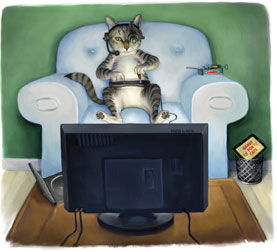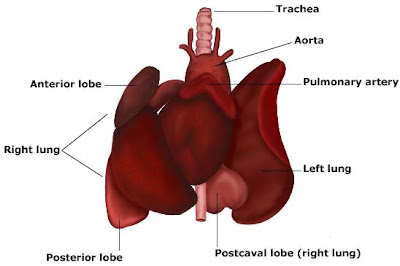 In England, a black cat brings good luck and the tail black cat heals sty on the eye, if to put it to the century. For the treatment of warts is the right tail tricolor cat.
In England, a black cat brings good luck and the tail black cat heals sty on the eye, if to put it to the century. For the treatment of warts is the right tail tricolor cat.
Ancient Vikings also considered the cat sacred. Norwegian Forest Cat mentioned among pets, which the Vikings held on board ships. Similar they trot: thick frill, "brushes" on ears and long hind legs. The first data are dated 1599 year.
Specialists University of Lyon (France) decided to calculate how much the world of home cats. It turned out that they are on the planet 400 million. Most cats in the United States.
However, the palm give Australia where for every 10 residents accounted for 9 cats. On the Asian continent, first in Indonesia, there are more than 30 million fluffy cat, but in Europe - in France, whose inhabitants are under his tutelage 8 million cats. However, there are countries, such as Peru, Gabon, and some others where domestic cat almost never.
Man respects these magnificent animals. In Japan, for example, at the gates of houses standing figures of cats - a symbol of home and comfort. In Russia, according to tradition, the threshold of a new home first crosses the cat.
As you know, nature had brought humans and animals very different periods of life. Meanwhile, youth, maturity and old age are inherent in all living beings.Naturally, admission to a particular age varies depending on the species. Yes, a month kitten is in the same stage of development as a human baby 5-6 months old. The six-month cat "contemporary" seventh graders (14 years) and fourteen - semidesyatidvuhletneho old.
Cats have one thing in common with giraffes and camels - they "pacers": originally raised both right front and hind legs, and then at the same time - left. In addition, cats - the only animals that do not rely on walking on foot pads, and claws.
cat was in King Charles I, and he believed that without him happiness no issue. He loved her, that she had appointed to guard individual ... but worth overlooked, the cat died. A few days later King Charles was beheaded.
There are many people who are not just in love with these charming tenants, but also connect with them many years of life. Familiar to us from the book of Alexandre Dumas 'The Three Musketeers' insidious personality Cardinal Richelieu was in the palace 12 cats living in his room. To them he showed a lot more good feelings than to people around him. Ernest Hemingway, the famous writer had in his house 150 cats! A world chess champion Alekhine had a live mascot. Favorite Siamese cat chosi (Chess) sat in the hall to his wife's lap during the match Alekhine - Lasker, at a tournament in 1934 in Zurich. Alekhine often descended from the stage in the auditorium to pat his favorite cat.
Traces "mystical" cats are reflected in the tales-remember majestic figure Kota Baiyun - "sitting on a pole, pobyvayuschyy entire nation, whistle Enduring dream and tell a story," Kotofeicha that won the Snake and taught men to make fire. Pushkin Cat Scientist is not so simple: the image of Dubai - a symbol of the World Tree, or Tree of Life, a gold chain - symbol path, (by the way, confused - the word "way"), on which day and night this pundit goes. Correlation with regal goddess of secret knowledge - Isis.Children else know Cat Thief-cat with velvet belly, other significant members of the feline tribe. Story Battle Cat from Dragon into a game of cat and mouse, where Côte always emerges victorious.
The Russian Old Believers in the early XVIII century cat acted as satirical images of Peter I. When in Egypt entrenched Islam, cats still continued to respect, at least, more than dogs, declared the Koran "unclean animals". And all because personally Prophet Muhammad loved cats - one asleep on his robe, and he had to go to spread Islam. Then he cut the floor where the cat asleep - is not to disturb the sleeping animal.Later, Mohammed, among other titles, also known as the father of cats.
Separately on cat eye: it is a very useful "tool" - the shape and size of the pupil in antiquity could with sufficient accuracy to determine the times of the day. Later invented the photo and began to use the cat eye as Exposure meter.Every self-respecting photographer, except bulky apparatus on a tripod, dragged on his shoulders as cumbersome, fed, full of dignity cat (preferably black). And before the cat had the honor to rise on the shoulders of sorcerers and magicians.
The Egyptians believed that the soul of the deceased housewife after death hiding in the body of a cat. During a fire, the Egyptians originally carried a cat, and then the stuff.
As you know, cats are not slaughtered in the fall even from a great height. Why? This question interested professor at Washington University Huayna Whitney. After examining the circumstances of the 132 successful downs animals, he found that cats helps so-called "parachute effect": their legs are extended, and the body expands, reducing the rate of fall. With a minimum height same cat used, primarily, the elasticity of their paws.
All cats and cats - great and people need animals. It is not for nothing that doctors have found that the presence in the house cat or dog brings a person even with infarct zone. Pat cat and decrease blood pressure, silent indignation ... * Back in the 30's, Dr. Joseph Vanco Ryan founded at Duke University (CA), the world's first laboratory parapsychology. As a result of extensive research scientist acknowledged that cats possess paranormal abilities such as foresight and telepathy. Simply put, they can advance to feel approaching danger and at great distances to learn about trouble or death of the owner. Later, other researchers - Nobel Prize winner Niko Tinbergen Dutchman and his colleague Robert Morris - will open in cats ability to use more and psychokinesis (moving objects nonphysical ways), and clairvoyance (getting information on some inanimate objects.) More than half a century, these cat "psi" widely studied in Europe, America and the former USSR.
are owners of cats, leaving a huge legacy of his four-pupils. So, once there was a curious incident described in the book tamer cats Yu Kuklachova "My Favorite Cats." He writes: "In Switzerland there are cats that have their own bank account. Rich housewife put on the account of these animals part of his fortune. And recently, the cats had first exchanged their equity. Royal Society for the Protection of Birds has fined them two pounds "for the systematic killing of birds." A check is signed to care for cats, because bank employees refused to take the form of prints of his paws tailed depositors. " * They say that the invention of iodine assistance had a cat that accidentally overturned flask with different liquids, spilling them. When connected together, the liquid formed a great way as iodine, which is used worldwide for lubrication wounds.
In Japan, in the city of Kagoshima, is the temple of cats. Built it in memory of the seven cats absolutely certain that a commander in 1600, he took with him to war. Cats were soldiers Hours: by expanding or shrinking cat pupil Japanese were able to determine the time. Now this temple visit most watchmakers ... * In ancient Siam, that Thailand is the princess kept cats. When Siamese princess went swimming, then they put their rings on the tail of these cats.
Since all Siamese cats a bad character and curved tail tip. This legend. And about Siamese cats say they guarded the treasures of Buddhist temples in the jungle, they were the only friends are sitting in prison unnecessary Siamese princes. There is another legend - supposedly Siamese cat in Siam had never lived. And called them so simply because it is the King of Siam gave these cats their favorite British consul.
Whatever it was, the French magazine "Life of Animals" unearthed for the first time in Europe Siamese cats appeared in London in 1884 hodu.Pohozhee

























+(2).jpg)
+(2).jpg)


.JPG)
